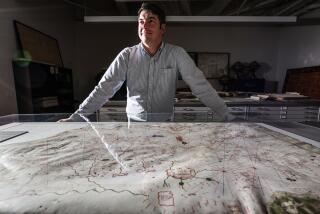Map or GPS? It all depends

Question: When we were in Britain a couple of years ago, we got a great spiral-bound map book, about 12 by 14 inches, that was large scale. It was easy to find back roads. We will be in Italy for our 25th wedding anniversary, and I cannot find a large-scale map. Any suggestions?
Sally Backus
Salinas, Calif.
Answer: Two sources, one answer: Michelin.
“It’s the kind of detail you would expect from a modern road atlas,” said Rob Burns, director of marketing for Goleta, Calif.-based Maps.com, an online map retail store that serves consumers as well as business and educational communities. He also likes Hema maps for tourist purposes.
Eugene Turner, a professor of geography at Cal State Northridge, concurs, yet he thinks GPS might be a better solution for some travelers.
Which method you choose depends on your comfort level navigating with a map. A map allows you to see the big picture, Burns said; a GPS tells you where to go, Turner said.
If you go with the paper map, Turner said, know that reading it is both a talent and a skill. If you’re not born with the talent, you can develop the skill. How? Same answer as the punch line to the old “How do you get to Carnegie Hall?” joke: Practice, practice, practice.
You can take a class, join a scouting organization (or, more extremely, the military) or the Los Angeles Orienteering Club (www.losangelesorienteering.org), which describes orienteering as “an organized sport for individuals, navigating a course by hiking or running to find your way through the trees and fields.”
When I pressed Turner about whether men or women are better at reading maps, he said that the spatial reasoning required for map reading may come more naturally to certain groups of people. When I cited my long-held but completely anecdotal belief that men are better at spatial relationships, Turner diplomatically demurred, refusing to say that women don’t do as well as men in map reading. So for further anecdotal confirmation, I conferred with my husband, who laughed and said that if I’m the test case, then, yes, men do better with maps and women do better with GPS because that involves listening. (I won’t even mention the rest of that conversation.)
Even if you stink at map reading (thanks, hubs), there is something about a map that encourages dreaming and visualizing where you might be next.
The marriage of data and geography means the world of maps can be quite niche, Burns said. If you want to travel to see lighthouses in the U.S., or wine-tasting areas or diving spots, there’s a map for that.
There’s even a map that will help you find (or avoid) rat-infested areas of New York City. Its odd-but-useful-bedfellow site, courtesy of the New York City Department of Health and Mental Hygiene, allows you to punch in an address to find out whether a place is Rodentville (www.lat.ms/1btn2Cy). Happy to report that the Manhattan hotel where I stayed last fall passed its most recent inspections.
Maps can chronicle changes in a way that also reveal history: Burns said Maps.com has a century-old trove of National Geographic maps that can show the earth-shattering changes in Europe, pre-World War I, post-World War I and post-World War II.
However you want to navigate, remember to look up from where you’re going to see and savor where you are.
Have a travel dilemma? Write to travel@latimes.com. We regret we cannot answer every inquiry.
More to Read
Sign up for The Wild
We’ll help you find the best places to hike, bike and run, as well as the perfect silent spots for meditation and yoga.
You may occasionally receive promotional content from the Los Angeles Times.







